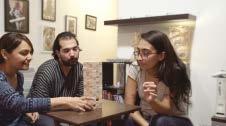Scope
and Sequence and ACTFL Correlations









KLETT WORLD LANGUAGES is a publishing house specializing in print and digital instructional materials for learning and teaching world languages.
Our mission is to help students become global citizens by developing their intercultural and critical thinking skills through language learning. We aim to help students learn and use language in real-life situations by creating engaging and meaningful content that sparks their curiosity and motivates them to learn.
We strongly believe that teachers play a key role in language learning, and part of our mission is to support them and to provide ample opportunity for professional development.
Having them is not enough. We live by them.
Because everyone on the core KWL team has a background in education and works closely with educators and students, our commitment goes far beyond our daily work. We understand the needs of educators and students and we are passionate about looking for solutions and tools to help them succeed.
We are committed to providing high-quality print and digital content at affordable prices to all who want to learn a language. We guarantee lower prices for high-quality content and simple, easy-to-use technology.
We view languages as tools for communication and action. To learn a language and build authentic communicative competency, students need a realistic context, a true need to communicate, a focus on meaning, and the right linguistic resources. That is what we provide in our educational materials.
Our educational materials focus on the most current pedagogical methodology. They follow the ACTFL Guidelines for Proficiency, include Can-Do statements, and address the 5 Cs. Our digital resources provide original and authentic content via a simple and easy-to-use platform.
We see educators as our partners, and the core of our mission is to support them by providing professional development opportunities, highquality documents and activities, and instructor resources in an easily accessible format.
Our content is created to help students use language to communicate and interact with other communities and cultures both in the United States and abroad. Our books present a respectful, modern, and open-minded perspective of our world and its cultures that allows students to dismantle stereotypes and to cultivate an awareness of global concerns.
You will learn how to introduce yourself and write a text or piece of writing for an online platform.
You will learn how to talk about noteworthy personalities in the Spanish-speaking world.
` Introduce yourself and others
` Exchange personal information (I)
` Talk about your Spanish class
` Interview: Hola, soy Marcela (Mexico)

` Exchange personal information (II)
` Ask and answer questions
` Express likes and dislikes using me gusta/n, te gusta/n
` Videoblog: Nuestros artistas favoritos (Guatemala)
` Activities to learn a language
` Interesting topics in a Spanish course
3 Mi entorno
You will decide what you want to do in your Spanish class and will apply to a study-abroad program in a Spanish-speaking country.
` Express degree using muy, un poco (de)…
` Talk about abilities and knowledge
` Exchange personal information (III) (telephone, email, address…)
` Express intentions and wishes
` Personal information
` Nationalities and professions
` Numbers 1 to 500
` Adjectives to describe personality

` Short film: Espronceda (Spain)
` Languages
` Leisure activities
` The family
` The verbs saber and conocer

` Subject pronouns (I)
` The present tense of regular verbs (I)
` The verbs ser and llamarse
` Nouns: gender and number
` Definite articles
` Alphabet and sounds
` Present tense of regular verbs (II) and the irregular verbs ser, ir, tener, hacer
` Indefinite articles
` Adjectives: gender and number
` Subject pronouns (II)
` Communication resources in the Spanish classroom
` Basic etiquette
` How to create a text
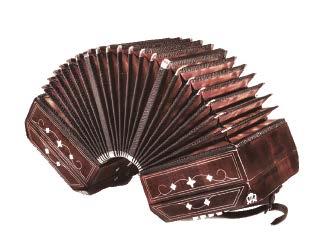
` Question words (I) questions
Basic connectors: y (e), pero, por eso, también
` Studying vocabulary

` Stem-changing verbs: e - ie, o - ue, u - ue, e - i
` Irregular verbs in the present: irregular yo forms, verbs with more than one irregularity
` Giving a reason: porque, para, por
` Possessive adjectives
` Rules of accentuation ` Vowels
` Writing emails
` The preposition de

` Linguistic landscape (USA)
` Artistic heritage of the Spanishspeaking community in the United States
` Group: introduce yourselves to the class
` Individual: introduce yourself in writing on an online platform

` Celebrities in the Spanish-speaking world
` Cinema and identity in Mexico
` Portraits and selfportraits. David Alfaro Siqueiros (Mexico), Coqui Calderón (Panama), and Dr. Atl (Mexico)
` Group: research and present basic information about the most influential Latinos in the US
` Individual: make an infographic about five influential people in the Spanish-speaking world
` The first academy of an indigenous language: guarani (Paraguay)
` Fernando Iwasaki. Las palabras primas (Peru)
` Group: interview classmates and decide what you want to do in your Spanish class
` Individual: apply to a study-abroad program in a Spanish-speaking country
` Indicate location
` Identify places
` Describe and compare
` Video report: Las líneas de Nazca: Patrimonio de la Humanidad (Peru)
` At school
` Numbers
` Colors
` Housing, rooms, and furniture
` Location: encima/ debajo de, al lado de
` Places, geography, and culture
` Climate and weather You will make a video report about World Heritage Sites.
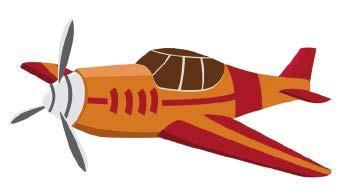
You will present a diverse and inclusive image of a place in the Spanish-speaking world.
` Talk about daily routines
` Express likes, interests, and preferences
` Express agreement and disagreement
` Short film: Chicas Day (Spain)

` Talk about travel
` Talk about past actions and events
` Describe places
` Give advice and make recommendations
` Interview: Un venezolano en Lima (Peru)
` Months and seasons
` Telling time
` Routine actions
` The academic calendar and school life
` Ordinal numbers 1 to 10
` Free time activities
` Travel
` Types of accommodation
` Restaurants

` The verbs ser and estar
` Uses of hay
` Comparatives
` Superlatives
` Formulating questions: question words (II)
` Stressed vowels
` Accentuation rules
` Use of the relative pronouns que, donde
` Objective and subjective descriptions
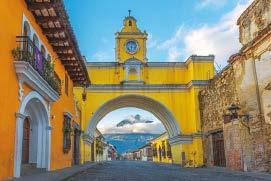
` The verbs gustar, encantar, and interesar
` Reflexive verbs
` Empezar a, terminar de, tener que + infinitive
` Talking about quantity: poco, suficiente, mucho, demasiado
` Word-ending vowels
` Organizing information
` Contrasting arguments
` Making a poster
` World heritage sites in the Spanishspeaking world
` Geography and history in the Spanish-speaking world
` Places of interest in Nicaragua
` Architectural styles in Guatemala
` Group: Make a video report about two places that are World Heritage Sites
` Individual: prepare a travel guide on your community or another place of your choice
` The preterite of regular verbs
` The preterite of
` People of Panama
` Images of Spain in art

` Change of meaning due to stress
` Unstressed

` Connectors of cause: porque, como, por eso
` Connectors of consequence: así que, de manera que
` Time markers
` Relative pronouns: donde, en + el/la/ la/los/las + que
` Learning journals
` Countries and cities in the Spanishspeaking world
` The Caribbean and its pirates
` Travel literature: Andrés Neuman (Argentina)
` Group: Prepare a presentation about a place in a Spanish-speaking country
` Individual: Write about an important day in your community
` Group: make a presentation about historical journeys and travelers
` Individual: write a historical blog about a group who migrated
En
este capítulo vas a realizar un cuestionario para conocer mejor a tus compañeros/as.
` Talk about personality
` Talk about skills
` Talk about projects
` Talk about likes and interests
En este capítulo vas a aprender a hablar de historia.
` Describe people, objects, places and situations in the past
` Talk about habitual actions in the past
` Talk about changes and similarities
En este capítulo vas a contar una historia a partir de una imagen.
` Express agreement and disagreement
` Talk about what we would do in certain circumstances

Talk about past events
Talk about feelings and emotions
Describe an object
` Institutional advertising: La voz es nuestra (Mexico)
` Personality Adjectives
` Room and furniture
` Free time activities

` Interview: Denisse Hellion, antropóloga (Mexico)
` Historical periods and events
` Opposites
` The stages of life

` Short-film: Juntos en familia (Chile)
` The verbs prestar, dejar, pedir, and deber
` Feelings and emotions
` Social relationships
` Romantic relationships
` Objects: shape, material…

` The preterite of regular verbs
` The preterite of ir, ser and hacer
` Ser and estar
` Verb constructions with infinitive: tener que + infinitive, ir a + infinitive
` Demonstrative adjectives and pronouns
` The present progressive
` The imperfect of regular and irregular verbs
` Time markers
` Possessive adjectives and pronouns
` The rhythm of Spanish
` Doing an online presentation

` Review of intonation and sounds
` The consonants

` The preterite: irregular verbs
` Direct and indirect object pronouns
` Double object pronoun
` Contrast of preterite / imperfect
` r and rr
` Connectors for contrast: aunque, a pesar de que, y eso que
` Revising a text
` Indigenous peoples in Latin America
` Indigenous languages
` New musical trends
` Women and the Mexican Revolution
` Juan Gelman (Argentina)
` Group: do a presentation on an indigenous group
` Individual: create a questionnaire to get to know your classmates
` Narrative markers
` Reacting to what others say
` The literary narrative text

` Mexico and Surrealism
` A short story by Almudena Montero (Spain)
` Group: make a presentation on life prior to a major historical event
` Individual: life in a city over time
` Group: tell a story based on a picture or painting
` Individual: write a story

Scope and Sequence
Scope & Sequence
En este capítulo vas a aprender a hablar sobre moda y a escribir recomendaciones para comprar ropa.
` Examine and give opinions about the world of fashion
` Talk about clothing
` Talk about the human body
` Give advice and orders
` Make suggestions
` Refer to something already mentioned
En este capítulo vas a aprender a preparar un menú y a escribir un artículo sobre comida para un blog.
` Talk about eating habits
` Order food in a restaurant and devise a menu
` Describe a dish
` Give instructions
` Give advice, and make suggestions
` Ask and answer about preferences
` Comment and give personal opinions
Vas a aprender a prepararte para una entrevista de trabajo y a hacer un video de presentación.

` Video report: De compras (Mexico)
` Clothing and accessoires
` Materials and patterns
` Colors

` Recipe video: Un plato peruano (Peru)
The body
Verbs referring to clothing: ponerse, llevar, probarse and quedar bien/ mal
` Dishes and recipes
` Weights, measurements and packaging

At the restaurant
Illnesses and health problems
` Talk about experiences
` Express feelings
` Talk about skills and talents
` Talk about future plans
` Talk about the way we acquire an ability
` Video résumé: Un vídeo de presentación
` The world of work
` Adjectives to describe moods
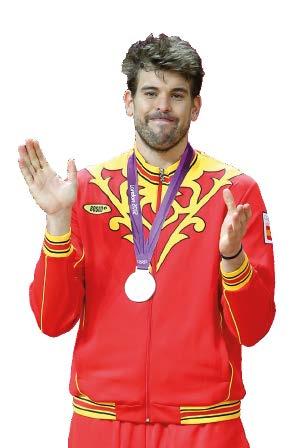
Abilities and personality
Professions and experience
` Affirmative and negative tú commands
` Pronouns with commands
` Conditional sentences: si + present, command / si + present, present
` p, t, and k

` Commands with usted and ustedes
` Giving instructions using the infinitive, the command forms and the present
` Giving instructions using constructions with se
` Giving advice and recommendations
` Stressed syllables
` Intonation: orders and instructions
` Text cohesion devices
` Referring to something already mentioned
` Characteristics of a journalistic text
` Alpaca fiber (Peru)
` New Latin American designers (Bolivia and México)

` Texts to comment on and analyze graphs
` Analyzing and commenting on graphs

` Uses of the present participle
` The present perfect
` Uses of por and para
` Past participles used as adjectives
` Forward positioning of t/d
` Connectors of sequence: en primer lugar, en segundo lugar, por último
` Giving an oral presentation
` Gastronomic cultures in the Spanish-speaking world
` Venezuelan arepas
` Cooking in the detective novels of Leonardo Padura (Cuba)
` Group: develop guidelines for buying clothes
` Individual: write an article about buying clothes
` Group: present a typical Hispanic menu
` Individual: write an informative article for a blog about nutrition and health
` The job market in Spain and Latin America
` Skills needed to find a job
` Education in Costa Rica
` The photographer Karla Gachet (Ecuador)

` Group: practice a job interview
` Individual: produce a video résumé

Scope and Sequence
Scope & Sequence
En este capítulo vas hacer una reseña en video de un producto cultural.
` Discuss art, literature, music and entertainment
` Talk about sports
` Compare cultural products
` Narrate a story in the past
` Blue & Malone: Casos imposibles (animated short film, Spain)
` Culture ` Entertainment ` Sports

En este capítulo vas a aprender a hablar sobre el futuro.
` Make predictions
` Talk about future actions
` Place an action in the future
` Express gradual increase or decrease
En este capítulo vas a proponer soluciones para mejorar la gestión del tiempo.
` Compatible (short film, Spain) ` Education and learning
` Ya, aún no / todavía no
` Technological advancements
` Future and career

` Compare statistics, data, and schedules
` Talk about future events
` Give advice
` Catalina (short film, Mexico) ` Time management

` Preterite vs. imperfect (review) and the past progressive
` Pronouns: direct object, indirect objetc, double object pronouns (review)
` Comparisons and superlatives: mejor, peor
` Time expressions with hacer
` Intonation of subordinate clauses when telling a story
` How to prepare an online review
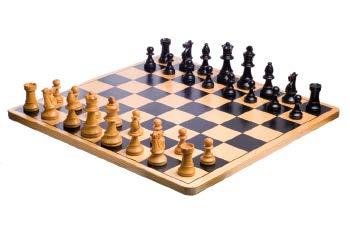
` A documentary: Lorena la de pies ligeros (Mexico)
` A graphic novel: Mocha Dick (Chile)
` Group: create and play a game about culture and entertainment
` Individual: create a video review of a cultural product
` The future
` Talking about actions: starting, stopping and duration (seguir + present participle, empezar a/ dejar de + infinitive)
` Conditional sentences with future. Review of conditional sentences with present / commands
` The present subjunctive
` Giving advice and making comments: es + adjective + infinitive / que + subjunctive
` Using the subjunctive or the indicative with cuando
` b, d and g
` The intonation of non-neutral questions
` Organizing information: por un lado, … por otro lado; por una parte, … por otra parte
` Time markers
` Online discussion boards
` Hispanic and latinx presence in the US
` Education in the US: Victor Rios

` Use of the comma
` Interpreting an argumentative text
` The article lo

` Mayan time (Mexico, Belize, El Salvador, Honduras)
` A poem by Gioconda Belli (Nicaragua)
` Group: prepare a group presentation about the future of some specific areas (work, education, etc.)
` Individual: make a video to present what your life will be like 15 years from now.
` Group: propose solutions for improving your time management
` Individual: write a report on students’ schedules
Scope and Sequence
Scope & Sequence
En este capítulo vas a hacer un cuestionario sobre la conciencia ecológica de tu comunidad.
` Make suggestions and give advice
` Explain problems and discuss the causes
` Express wishes and desires, needs, requests, and complaints
5 Emociones
En este capítulo vas a crear un autorretrato emocional.
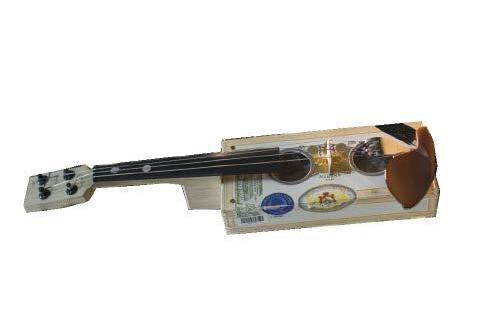
` Express emotions
` Thank, congratulate and apologize
` Give advice, persuade and influence others, and ask for something politely
6 Historias y desafíos
En este capítulo vas a aprender a hablar de acontecimientos históricos.
` Describe historical events
` Express opinion
` La audición (short ` Emotions and

` Express agreement and disagreement ` Sorojchi (documentary, Bolivia) ` History and politics

` Expressing wishes and desires: querer, esperar, desear que and ojalá + subjunctive
` Making requests and demands: pedir, exigir, solicitar que + subjunctive
` Making recommendations and suggestions (I): recomendar, aconsejar and sugerir que + subjunctive
` The conditional
` Expressing feelings and emotions: encantar, molestar que + subjunctive
` Verbs to express feelings and emotions in reflexive constructions
` Making recommendations with ser and parecer
` G and j
` The ch group
` Connectors of cause and effect
` Text cohesion devices
` Translating a text
` Barro Colorado (Panama)
` Contemporary art in Chile. Los quipus de Cecilia Vicuña
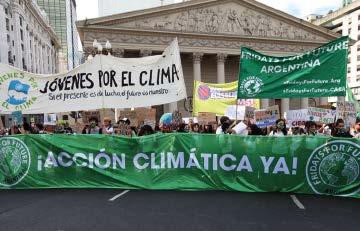
` Universal intonation patterns compared to those specific in Spanish
` Expressive and directive speech acts
` Intensifying with qué and cómo
` Combining speech act
` How to write a film review
` An interview with Lita Cabellut (Spain)
` Uruguayan poetry: Idea Vilariño and Mario Benedetti
` Group: create a survey about ecological conscience and propose steps to improve the situation
` Individual: write an article for your school’s blog about the environment
` The past perfect
` Narrating past events
` Relative clauses with preposition (a la que, con el que, para los que…)
` Como/cómo, cuando/cuándo, donde/dónde
` The letter ñ
` Accents on word
` Enriching vocabulary: nominalization
` The historical (narrative) present
` The use of metaphors in journalism
` Group: record a short film about emotions
` Individual: create an emotional selfportrait

` The history of El Salvador
` Writers in Spanish and the Hassaniya language of the Western Sahara
` Group: present a historical event through a memorial site
` Individual: make a timeline depicting achievements in recent centuries
Scope and Sequence
Scope & Sequence
En este capítulo vas a hacer un noticiario en formato podcast con noticias positivas y a redactar un artículo o una noticia sobre un avance científico.
` Analyze and discuss facts
` Talk about the news
` Understand texts about scientific news
` Documentary: La eminencia (documentary, Spain)
` Science ` Current affairs ` Ethics

En este capítulo vas a aprender a diseñar una campaña publicitaria y a opinar sobre un tema relacionado con la publicidad.
En este capítulo vas a investigar sobre personas influyentes en internet que hablen o escriban en español.
` Express personal opinions and make comments
` Express purpose
` Construct an argument
` Explain what something is
` Advertising campaign: Héroes que nos inspiran (Argentina)
` Marketing and advertising
` The goals of advertising

` Reported speech
` Understanding apologetic texts
` Talk about future actions (II)
` Short film: Por su cuenta (Colombia)
` The internet and social media
` New ways of working
` Anglicisms
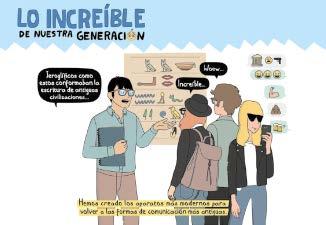
LANGUAGE STRUCTURES SOUNDS
` Subjunctive (Overview)
` Subjunctive with conjunctions
` Subjunctive with the unknown
` Consonant + r, consonant + l
` How to create a podcast

` Negating and expressing certainty with the subjunctive and indicative
` Expressing purpose: para +infinitive / para que + subjunctive
` Word families
` Exclamatory intonation
` Connectors of addition
` Advertising
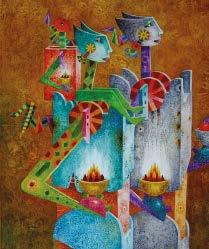
` Indicative vs. subjunctive with que, quien(es), como, cuando, donde, como
` The future perfect
` Reported speech
` The ll group
` Expressing doubt through intonation
` Four technological advances for a better world (Argentina, Ecuador, Guatemala, Peru)
` The photography of Juan Pablo Gutiérrez (Colombia)
` Group: create a news broadcast featuring a positive story
` Individual: write an informative news article about a scientific topic.
` The No Campaign (Chile)
` Orlando Arias: art and consumerism (Bolivia)
` Precision and lexical variety: alternatives to the verb decir
` Summarizing

` Barbarita Lara’s emergency alert system (Chile)
` Kentukis, de Samanta Schweblin (Argentina)
` Group: design an advertising campaign
` Individual: write an opinion essay about a topic related to advertising practices
` Group: give a presentation about an influential Spanish-speaking internet personality
` Individual: write an article comparing two influential people
En este capítulo vas a aprender a diseñar una campaña de promoción de una tradición y a hablar de tradiciones controvertidas.
` Talk about past events
` Describe traditions
` Express opinions about events
` Video report: La fiesta de la Candelaria (Mexico)
` Traditions, celebrations, and rites

En este capítulo vas a aprender a hablar de los logros de mujeres importantes del mundo hispanohablante.
En este capítulo vas a aprender a hacer un mapa de tu aprendizaje del español.
` Express wishes
` Report what someone said
` Conditions with different degrees of probability
` Video report: Feminismo en Perú (Peru)
` Discrimination and society

` Describe contraryto-fact situations in the past
` Discuss past and future events
` Make hypotheses about how things could have been in certain circumstances
` Mockumentary: Let's go to Antarctica! (Spain)
` Geography
` Nature and landscape
` Imaginary worlds
` Learning

` Passive constructions
` Emphasizing with lo + adjective / adverb
` Narrating past events (review)
` The letter l ` Alternative questions
` Expressing impersonality
` Expository text

` Conditional sentences: si + imperfect subjunctive, conditional
` Reported speech with requests and advice
` Expressing wishes with the imperfect subjunctive
` Pronunciation differences in Spanish around the world
` Academic texts

` Traditions, celebrations, and rituals in the Hispanic world
` Popular festivities in Honduras
` Alexis DíazPimienta, Cuban repentista poet
` Group: design an ad to promote a cultural event in a Spanish-speaking country
` Individual: write a report about a controversial tradition
` The present perfect subjunctive
` The past perfect subjunctive
` The conditional perfect
` Past conditionals
` Parenthetical intonation
` Intonation to express obviousness and doubt
` Past, present and future of women
` Significant contributions to the Spanish-speaking world made by women
` Puerto Rico and the bolero
` Susana Baca, Peruvian musician
` Group: do a presentation about a woman who played a key role in the history or politics of Latin America
` Individual: write an academic essay about the representation of women in art

design and create a map about
Write an email to the future

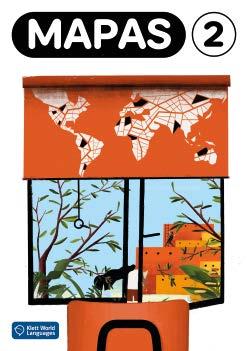


To explore and download these
please visit klettwl.com/state-specific-support
LEVEL: NOVICE LOW TO NOVICE HIGH
ACTFL World-Readiness Standards

Communicate effectively in more than one language in order to function in a variety of situations and for multiple purposes
Interpersonal Communication: Learners interact and negotiate meaning in spoken, signed, or written conversations to share information, reactions, feelings, and opinions.
CAPÍTULO 1: p. 4 (act. 2, 3, 4), p. 5 (act. 6, 7, 8, 9), p. 6 (act. 13, 14, 15, Foro de discusión), p. 8 (act. 17, 18, 20), p. 11 (act. 22, 23, 24), p. 12 (act. 25, 26, 27, Foro de discusión), p. 13 (act. 30, 31), p. 14 (act. 33, 34), p. 15 (act. 35, 36, 37, 38), p. 16 (act. 39), p. 17 (act. 41), p. 18 (act. 42), p. 21 (act. 50), p. 22 (Proyectos: En grupo)
CAPÍTULO 2: p. 34 (act. 3, 4), p. 35 (act. 7, Foro de discusión), p. 36 (act. 10, 12, 13, Foro de discusión), p. 39 (act., 16, 17, 20), p. 40 (act. 21), p. 41 (act. 25), p. 43 (act. 29, 30, 31, 32, 33), p. 44 (act. 35, 36, 37, 38), p. 45 (act. 40, 41, 42, 43, 44, 45), p. 47 (act. 48, 49, 50, 51, 52, 53), p. 48 (act. 55, 56), p. 49 (act. 57, 58, 59, 60), p. 50 (act. 61), p. 51 (act. 64), p. 53 (act. 67, 68), p. 54 (act. 69), p. 55 (act. 70, 72, 73), p. 56 (Proyectos: En grupo)
CAPÍTULO 2: p. 68 (act. 2, 3, 4), p. 69 (act. 6, 7, 8, Foro de discusión), p. 70 (act. 12, 13, 14, 15, Foro de discusión), p. 73 (act. 18, 19, 20, 21), p. 75 (act. 24, 25), p. 76 (act. 28, 29, 30, 32, 33, 34), p. 77 (act. 36, 37, 38), p. 78 (act. 40), p. 79 (act. 41, 42, 44, 45), p. 81 (act. 47, 48, 49, 50, 51, 52, 53, 54), p. 82 (act. 55, 56, 57, 58, 59, 60), p. 83 (act. 61, 63), p. 84 (act. 64, 65, 66, 67, 68), p. 85 (act. 69, 70, 71, 72), p. 87 (act. 75), p. 89 (act. 78, 79, 80, 81), p. 90 (act. 82), p. 91 (act. 86), p. 92 (Proyectos: En grupo), p. 93 (Proyectos: Individual)
CAPÍTULO 4: p. 106 (act. 2), p. 107 (act. 4, 5, 6, 7), p. 108 (act. 11, 12, Foro de discusión), p. 110 (act. 13, 14, 15, 16), p. 111 (act. 17, 18, 19, 20, 21), p. 112 (act. 28, 29), p. 114 (act. 31, 32, 34, 35), p. 115 (act. 36, 37, 38), p. 116 (act. 39, 40, 41), p. 117 (act. 42, 43, 44, 45), p. 118 (act. 46, 47, 48, 49, 50, 51, 52), p. 119 (act. 53, 54), p. 120 (act. 55, 58, 59), p. 121 (act. 60, 61, 62, 63, 64, 65), p. 122 (act. 68, 69, 70), p. 123 (act. 71, 72, 73, 74), p. 124 (act. 75), p. 126 (act. 79), p. 127 (act. 81), p. 128 (act. 83), p. 129 (act. 85, 86, 87), p. 130 (Proyectos: En grupo)
CAPÍTULO 5: p. 146 (act. 3), p. 147 (act. 6, 7, 8), p. 148 (act. 13, 14, Foro de discusión), p. 150 (act. 16, 17, 19), p. 152 (act. 20), p. 153 (act. 21, 22, 23), p. 154 (act. 24), p. 155 (act. 25, 26, 27, 28), p. 156 (act. 29, 30, 31), p. 157 (act. 33, 34, 35, 36, 37), p. 158 (act. 39, 40), p. 159 (act. 42, 43, 44), p. 160 (act. 45, 46, 47, 50, 51), p. 161 (act. 52, 53, 54, 55, 56, 57), p. 162 (act. 58), p. 163 (act. 60, 61, 62), p. 164 (act. 63), p. 165 (act. 64, 65, 66, 67, 68), p. 166 (act. 71), p. 168 (Proyectos: En grupo), p. 169 (Proyectos: Individual) CAPÍTULO 6: p. 184 (act. 2, 3, 4, 5, Foro de discusión), p. 185 (act. 6, 8, 9, 11, 12, 13), p. 186 (act. 17, 18, 19, Foro de discusión), p. 188 (act. 23, 24, 25), p. 191 (act. 28, 29, 30, 33, Foro de discusión), p. 192 (act. 34, 35), p. 193 (act. 36, 37, 38, 39, 40, 41, 42, 43), p. 194 (act. 45, 46, 47), p. 195 (act. 49, 50, 51), p. 196 (act. 52, 53, 54, 55, 56, 57), p. 197 (act. 60, 61, 62), p. 198 (act. 64, 65, 66), p. 199 (act. 67, 68, 69, 70, 71), p. 200 (act. 72, 73), p. 201 (act. 74), p. 202 (act. 76), p. 203 (act. 79, 80), p. 204 (act. 81), p. 205 (act. 83, 84, 85, 87, 88), p. 206 (Proyectos: En grupo)
Interpretive Communication: Learners understand, interpret, and analyze what is heard, read, or viewed on a variety of topics.
CAPÍTULO 1: p. 4 (act. 1, 3), p. 6 (act. 10, 11, 12), p. 8 (act. 16, 19), p. 10 (act. 21), p. 13 (act. 28, 29, 31), p. 14 (act. 32, 34), pp. 16-17 (act. 40), p. 19 (act. 43, 44, 45, 46), p. 20 (act. 47), p. 21 (act. 48, 49)
CAPÍTULO 2: p. 34 (act. 1), p. 35 (act. 5, 6), p. 36 (act. 8, 9, 11), p. 38 (act. 14), p. 39 (act. 17, 19, 20), p. 40 (act. 22), p. 41 (act. 23, 24, 26, 27), p. 42 (act. 28), p. 44 (act. 34), p. 45 (act. 39), p. 46 (act. 46, 47), p. 48 (act. 54), p. 50 (act. 62), p. 51 (act. 63), p. 52 (act. 65), p. 53 (act. 66), p. 54 (act. 69), p. 55 (act. 70, 71), p. 56 (Proyectos: En grupo)
CAPÍTULO 3: p. 68 (act. 1), p. 69 (act. 5), p. 70 (act. 9, 10, 11), p. 72 (act. 16), p. 73 (act. 17), p. 74 (act. 22), p. 75 (act. 23), p. 76 (act. 31), p. 77 (act. 35), p. 78 (act. 39), p. 79 (act. 43), p. 80 (act. 46), p. 83 (act. 61, 62), p. 86 (act. 73, 74), p. 88 (act. 76), p. 89 (act. 77, 80), p. 91 (act. 83, 84, 85), p. 93 (Proyectos: Individual)
CAPÍTULO 4: p. 106 (act. 1), p. 107 (act. 3, 5), p. 108 (act. 8, 9), p. 110 (act. 16), p. 111 (act. 19, 22, 23), p. 112 (act. 24, 25, 26, 27, 29, 30), p. 114 (act. 33), p. 116 (act. 39), p. 117 (act. 45), p. 120 (act. 56), p. 122 (act. 66, 67), p. 123 (act. 74), p. 124 (act. 76), p. 125 (act. 77), p. 126 (act. 79), p. 127 (act. 80), p. 128 (act. 83), p. 129 (act. 84), p. 146 (act. 1, 2)
CAPÍTULO 5: p. 147 (act. 4, 5), p. 148 (act. 9, 10, 11, 12), p. 150 (act. 15, 18), p. 157 (act. 32), p. 158 (act. 38), p. 159 (act. 41), p. 160 (act. 48), pp. 162-163 (act. 59), p. 163 (act. 62), p. 165 (act. 64, 65, 66, 67), p. 166 (act. 69, 70), p. 167 (act. 72, 73)
CAPÍTULO 6: p. 184 (act. 1), p. 185 (act. 7, 10), p. 186 (act. 14, 15, 16), p. 188 (act. 21, 22), p. 190 (act. 26, 27), p. 191 (act. 30), p. 194 (act. 44), p. 195 (act. 48), p. 197 (act. 58, 59), p. 198 (act. 63, 66), p. 203 (act. 77), p. 204 (act. 81), p. 205 (act. 82, 83, 84, 86)
Presentational Communication: Learners present information, concepts, and ideas to inform, explain, persuade, and narrate on a variety of topics using appropriate media and adapting to various audiences of listeners, readers, or viewers.
CAPÍTULO 1: p. 4 (act. 5), p. 5 (act. 7), p. 6 (act. 15), p. 8 (act. 20), p. 22 (Proyectos: En grupo), p. 23 (Proyectos: Individual)
CAPÍTULO 2: p. 34 (act. 2), p. 39 (act. 15, 18), p. 56 (Proyectos: En grupo), p. 57 (Proyectos: Individual) .
CAPÍTULO 3: p. 75 (act. 26, 27), p. 79 (act. 42), p. 92 (Proyectos: En grupo)
CAPÍTULO 1: p. 108 (act. 10), p. 111 (act. 18, 21), p. 120 (act. 57), p. 121 (act. 64, 65), p. 125 (act. 78), p. 127 (act. 82), p. 130 (Proyectos: En grupo), p. 131 (Proyectos: Individual)
CAPÍTULO 5: p. 160 (act. 49), p. 161 (act. 57), p. 167 (act. 73), p. 168 (Proyectos: En grupo), p. 169 (Proyectos: Individual)
CAPÍTULO 6: p. 184 (act. 5), p. 185 (act. 9), p. 188 (act. 20), p. 191 (act. 31, 32), p. 196 (act. 55), p. 203 (act. 78), p. 206 (Proyectos: En grupo), p. 207 (Proyectos: Individual)
Interact with cultural competence
Relating Cultural Practices to Perspectives: Learners use the language to investigate, explain, and reflect on the relationship between the practices and perspectives of the cultures studied.
CAPÍTULO 2: p. 35 (act. 6), p. 48 (act. 54), p. 53 (act. 68)
CAPÍTULO 3: p. 68 (act. 1, 3), p. 80 (act. 46), p. 88 (act. 76), p. 89 (act. 77, 80)
CAPÍTULO 4: p. 108 (Foro de discusión) p. 118 (act. 49, 51, 52), p. 125 (act. 77)
CAPÍTULO 5: p. 146 (act. 1, 2), p. 148 (act. 9, 10, 11, 12), p. 157 (act. 32), p. 165 (act. 64, 65, 66, 67), p. 167 (act. 72), p. 168 (Proyectos: En grupo)
CAPÍTULO 6: p. 186 (act. 14, 15, 16), p. 188 (act. 21), p. 198 (act. 63), p. 203 (act. 77), p. 206 (Proyectos: En grupo), p. 207 (Proyectos: Individual)
Relating Cultural Products to Perspectives: Learners use the language to investigate, explain, and reflect on the relationship between the products and perspectives of the cultures studied.
CAPÍTULO 1: p. 13 (act. 31), p. 19 (act. 43, 44, 45, 46), p. 21 (act. 48, 49, 50)
CAPÍTULO 2: p. 34 (act. 1), p. 35 (act. 6), p. 38 (act. 14), p. 39 (act. 20), p. 43 (act. 33), p. 46 (act. 47), p. 47 (act. 49), p. 52 (act. 65), p. 53 (act. 66), p. 54 (act. 69), p. 55 (act. 70, 71, 72), p. 56 (Proyectos: En grupo), p. 57 (Proyectos: Individual)
CAPÍTULO 3: p. 69 (act. 5, 6), p. 70 (act. 9, 10, 11, 14, 15), p. 78 (act. 39), p. 91 (act. 83, 84, 85)
CAPÍTULO 4: p. 107 (act. 3), p. 108 (act. 8,9) p. 110 (act. 15, 16), p. 115 (act. 36), p. 117 (act. 45), p. 118 (act. 46), p. 122 (act. 66, 67), p. 123 (act. 74), p. 125 (act. 77), p. 126 (act. 79), p. 127 (act. 80, 82), p. 128 (act. 83), p. 129 (act. 84), p. 130 (Proyectos: En grupo), p. 131 (Proyectos: Individual)
CAPÍTULO 5: p. 148 (act. 9, 10, 11, 12), p. 161 (act. 57), p. 166 (act. 69, 70, 71), p. 167 (act. 72), p. 168 (Proyectos: En grupo)
CAPÍTULO 6: p. 184 (act, 1), p. 185 (act. 7, 10), p. 188 (act. 21), p. 195 (act. 48), p. 197 (act. 58, 59, 60), p. 198 (act. 63), p. 203 (act. 77, 78, 79), p. 204 (act. 81), p. 205 (act. 82, 83, 84)
Connect with other disciplines and acquire information and diverse perspectives in order to use the language to function in academic and career related situations
Making Connections: Learners build, reinforce, and expand their knowledge of other disciplines while using the language to develop critical thinking and to solve problems creatively.
CAPÍTULO 1: p. 20 (act. 47), p. 21 (act. 48, 49), p. 35 (act. 5, 6)
CAPÍTULO 3: p. 68 (act. 1)
CAPÍTULO 4: p. 114 (act. 31, 32, 33), p. 116 (act. 39, 40, 41), p. 128 (act. 83), p. 129 (act. 84)
CAPÍTULO 5: p. 147 (act. 4, 5, 6), p. 158 (act. 40), p. 166 (act. 69), p. 167 (act. 72, 73)
CAPÍTULO 6: p. 202 (act. 76), p. 203 (act. 77, 79, 80), p. 204 (act. 81), p. 206 (Proyectos: En grupo), p. 207 (Proyectos: Individual)
Acquiring Information and Diverse Perspectives: Learners access and evaluate information and diverse perspectives that are available through the language and its cultures.
CAPÍTULO 1: p. 19 (act. 43), p. 21 (act. 48, 49, 50)
CAPÍTULO 2: p. 35 (act. 6), p. 38 (act. 14), p. 40 (act. 22), p. 41 (act. 26), p. 42 (act. 28), p. 46 (act. 46), p. 48 (act. 54), p. 52 (act. 65), p. 54 (act. 69), p. 55 (act. 70, 71)
CAPÍTULO 3: p. 68 (act. 1, 2, 3), p. 72 (act. 16), p. 80 (act. 46), p. 89 (act. 77, 80), p. 91 (act. 83, 85)
CAPÍTULO 4: p. 110 (act. 16), p. 112 (act. 25, 26, 27), p. 114 (act. 31, 32), p. 115 (act. 36), p. 127 (act. 80), p. 129 (act. 84)
CAPÍTULO 5: p. 157 (act. 32), p. 158 (act. 40), p. 165 (act. 64), p. 167 (act. 72)
CAPÍTULO 6: p. 188 (act. 21), p. 194 (act. 44), p. 195 (act. 48), p. 197 (act. 59), p. 198 (act. 63), p. 203 (act. 77), p. 204 (act. 81)
Develop insight into the nature of language and culture in order to interact with cultural competence
Language Comparisons: Learners use the language to investigate, explain, and reflect on the nature of language through comparisons of the language studied and their own.
CAPÍTULO 1: p. 4 (act. 2), p. 5 (act. 8), p. 11 (act. 24), p. 14 (act. 32, 34), p. 15 (act. 35, 36), p. 17 (act. 41), p. 19 (act. 44, 45, 46)
CAPÍTULO 2: p. 36 (act. 12), 44 (act. 35, 36, 37), p. 45 (act. 42), p. 47 (act. 50), p. 48 (act. 55), p. 55 (act. 73)
CAPÍTULO 3: p. 70 (act. 14, 15), p. 79 (act. 41), p. 81 (act. 53), p. 84 (act. 64, 66, 67, 68), p. 85 (act. 71, 72), p. 87 (act. 75), p. 91 (act. 85)
CAPÍTULO 5: p. 152 (act. 20), p. 154 (act. 24), p. 161 (act. 52)
CAPÍTULO 6: p. 195 (act. 49), p. 199 (act. 69)
Cultural Comparisons: Learners use the language to investigate, explain, and reflect on the concept of culture through comparisons of the cultures studied and their own.
CAPÍTULO 1: p. 19 (act. 46)
CAPÍTULO 2: p. 35 (Foro de discusión), p. 36 (act. 12), p. 41 (act. 26)
CAPÍTULO 3: p. 68 (act. 1), p. 70 (act. 15)
CAPÍTULO 4: p. 119 (act. 53)
CAPÍTULO 5: p. 150 (act. 17), p. 157 (act. 32, 37), p. 159 (act. 42, 44), p. 165 (act. 68)
CAPÍTULO 6: p. 184 (act. 3), p. 188 (act. 24), p. 197 (act. 60), p. 202 (act. 76), p. 203 (act. 80)
Communicate and interact with cultural competence in order to participate in multilingual communities at home and around the world
School and Global Communities: Learners use the language both within and beyond the classroom to interact and collaborate in their community and the globalized world.
CAPÍTULO 1: p. 23 (Proyectos: Individual)
CAPÍTULO 3: p. 92 (Proyectos: En grupo)
CAPÍTULO 4: p. 125 (act. 78), p. 130 (Proyectos: En grupo), p. 131 (Proyectos: Individual)
CAPÍTULO 5: p. 168 (Proyectos: En grupo)
CAPÍTULO 6: p. 206 (Proyectos: En grupo), p. 207 (Proyectos: Individual)
Lifelong Learning: Learners set goals and reflect on their progress in using languages for enjoyment, enrichment, and advancement.
CAPÍTULO 1: p. 17 (act. 41), p. 23 (Proyecto Individual)
CAPÍTULO 2: p. 57 (Proyecto Individual)
CAPÍTULO 3: p. 92 (Proyectos: En grupo), p. 93 (Proyecto Individual)
CAPÍTULO 4: p. 130 (Proyectos: En grupo), p. 131 (Proyectos: Individual)
CAPÍTULO 5: p. 168 (Proyectos: En grupo), p. 169 (Proyecto Individual)
CAPÍTULO 6: pp. 200-201 (act. 73), p. 201 (act. 75), p. 206 (Proyectos: En grupo), p. 207 (Proyectos: Individual)
LEVEL: NOVICE HIGH TO INTERMEDIATE MID
ACTFL World-Readiness Standards
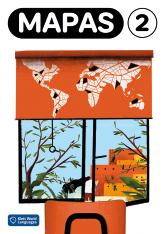
Communicate effectively in more than one language in order to function in a variety of situations and for multiple purposes
Interpersonal Communication: Learners interact and negotiate meaning in spoken, signed, or written conversations to share information, reactions, feelings, and opinions.
CAPÍTULO 1: p. 4 (act. 4, 5), p. 5 (act 6, 8), p. 6 (act. 12, 13, foro de discusión), p. 8 (act. 14, 15, 16, 18, 19), p. 11 (act. 21, 22, 23, 24), p. 12 (act. 27), p. 13 (act. 28, 29, 30, 31, 32, 34, 35), p. 14 (act. 38, 39, 40, 41), p. 15 (act. 45, 46, 47, 49, 50, 51), p. 16 (act. 54, 55, foro de discusión), p. 17 (act. 57, 59), p. 18 (act. 61), p. 19 (act. 62, 63, 64), p. 20 (act. 66, 67), p. 21 (act. 72, 73), p. 22 (act. 74, 75), p. 24 (act. 77), pp. 24-25 (act. 78), p. 25 (act. 79, 81, 82), p. 26 (act. 84), pp. 26-27 (act. 85), p. 27 (act. 86, 87), p. 28 (proyecto: en grupo),
CAPÍTULO 2: p. 40 (act. 3, 4, 5, 6, 7, 8, 9), p. 41 (act. 12), p. 42 (act. 18, 19), p. 44 (act. 23, 26, 27, 28), p. 46 (act. 32), p. 47 (act. 33, 36, 39, 40, 41), p. 48 (act. 45, 46, 47), p. 49 (act. 48, 49, foro de discusión), p. 50 (act. 52, 53, 54), p. 51 (act. 57, 58, 59), p. 52 (act. 63, 64), p. 53 (act. 70, 71), p. 55 (act. 74), pp. 56-57 (act. 79), p. 57 (act. 80), pp. 58-59 (act. 83, 84), p. 59 (act. 85), p. 60 (proyecto: en grupo)
CAPÍTULO 3: p. 70 (act. 2, 3, 4, 5), p. 71 (act. 7, 8, 9, foro de discusión), p. 72 (act. 15, 16, 17, foro de discusión), p. 74 (act. 21, 22, 24, 26, 27), p. 76 (act. 30, 31, 32, 33), p. 77 (act. 39, 40), p. 78 (act. 43), p. 79 (act. 45, 48), p. 80 (act. 50, 51, 52), p. 81 (act. 54, 55), p. 82 (act. 58, 59, foro de discusión), p. 83 (act. 61, 62, 63, 64), p. 84 (act. 66, 67, 68), p. 85 (act. 74), p. 87 (act. 77), p. 89 (act. 81, 82, 83, 84), p. 91 (act. 88, 89, 90), p. 92 (Proyectos: En grupo)
CAPÍTULO 4: p. 108 (act. 2, 3, 5), p. 109 (act. 8, 9, 10), p. 110 (act. 13, 14, 15), p. 112 (act. 19, 20), p. 114 (act. 25, 26, 27, foro de discusión), p. 115 (act. 29, 30, 32, 33, 34), p. 116 (act. 37), p. 117 (act. 40, 41), p. 118 (act. 42, 43, 47), p. 119 (act. 48, 49, 50, 51, 52, 53), p. 120 (act. 55, 56, 57), p. 121 (act. 61), p. 122 (act. 62), p. 123 (act. 65), p. 124 (act. 87), p. 125 (act. 70), pp. 126-127 (act. 73), p. 127 (act. 74, 75), p. 128 (Proyectos: En grupo)
CAPÍTULO 5: p. 140 (act. 4, 5, 6, foro de discusión), p. 141 (act. 9), p. 142 (act. 15, 16, 17, foro de discusión), p. 144 (act. 22, 23), p. 147 (act. 31, 32, 35, foro de discusión), p. 148 (act. 39, 40), p. 149 (act. 44), p. 150 (act. 45, 46, 47), p. 151 (act. 49, 52), p. 153 (act. 57, 58, 59, 60, 62), p. 154 (act. 65, 66, 67, 68), p. 155 (act. 69, 70, 71, 73, 74), p. 156 (act. 77), p. 157 (act. 79, 80, 81), p. 158 (act. 82), p. 159 (act. 84, 85, 86), p. 160 (act. 87), p. 161 (act. 89, 90, 91), p. 162 (Proyectos: En grupo)
CAPÍTULO 6: p. 174 (act. 2, 3, 4, 5), p. 175 (act. 7), p. 176 (act. 11, 12, foro de discusión), p. 178 (act. 14, 15), p. 179 (act. 18, 19), p. 181 (act. 22, 23, 26, foro de discusión), p. 183 (act. 30, 33, 34, 35, 37), p. 185 (act. 41, 42, 44), p. 186 (act. 47, 48, 49), p. 187 (act. 51, 52, 53, 54), p. 188 (act. 56, 57, 58), p. 190 (act. 67), p. 191 (act. 68, 69), p. 193 (act. 72, 73, 74), p. 194 (act. 75, 76), p. 195 (act. 78, 79), p. 196 (Proyectos: En grupo)
Interpretive Communication: Learners understand, interpret, and analyze what is heard, read, or viewed on a variety of topics.
CAPÍTULO 1: p. 4 (act. 1, 2, 3, 5), p. 5 (act 6, 7), p. 6 (act. 9, 10, 11, 13), p. 8 (act. 16, 17), p. 10 (act. 20), p. 11 (act. 22, 23), p. 12 (act. 25, 26, 27), p. 13 (act. 29, 31, 34), p. 14 (act. 36, 37, 39, 40), p. 15 (act. 42, 43, 44), p. 16 (act. 52, 53), p. 17 (act. 56, 58), p. 18 (act. 60, 61), p. 19 (act. 63), p. 20 (act. 65, 67), p. 21 (act. 69, 70, 71, 72), pp. 22-23 (act. 75), p. 23 (act. 76), pp. 24-25 (act. 78), p. 25 (act. 80), p. 26 (act. 83), pp. 26-27 (act. 85), p. 27 (act. 86, 87), p. 29 (Proyectos: Individual)
CAPÍTULO 1: p. 40 (act. 1, 2), p. 41 (act. 10, 11), p. 42 (act. 13, 14, 15, 16, 17), pp. 44-45 (act. 21,22), p. 44 (act. 20, 24, 25, 26, 27), p. 46 (act. 29, 30, 31, 32), p. 47 (act. 33, 34, 37, 38), p. 48 (act. 42, 43, 44, 47), p. 49 (act. 48), p. 50 (act. 50, 51, 53), p. 51 (act. 55, 56, 58), p. 52 (act. 60, 61, 62), p. 53 (act. 65, 66, 67, 68, 69, 71), pp. 54-55 (act. 72, 73), pp. 54-55 (act. 73), p. 55 (act. 74), p. 56 (act. 75, 76), p. 56-57 (act. 77, 78, 79), p. 58 (act. 81), pp. 58-59 (act. 82, 83, 84), p. 59 (act. 85), p. 60 (Proyectos: En grupo)
CAPÍTULO 1: p. 70 (act. 1, 4), p. 71 (act. 6), p. 72 (act. 10, 11, 12, 13, 14, 16), pp. 74-75 (act. 19, 20), p. 74 (act. 18, 22, 23), p. 76 (act. 28, 29, 30, 31), p. 77 (act. 34, 35, 36, 37, 38), p. 78 (act. 41, 42), p. 79 (act. 44, 46, 47), p. 80 (act. 49, 52), p. 81 (act. 53, 54), p. 82 (act. 56, 57), p. 83 (act. 60, 61, 62), p. 84 (act. 65, 66), p. 85 (act. 69, 70, 71, 72, 73), pp. 86-87 (act. 75, 76), pp. 86-87 (act. 76), p. 88 (act. 79), pp. 88-89 (act. 80), p. 89 (act. 81, 82, 83), p. 90 (act. 85), p. 91 (act. 86, 87, 88, 89, 90), p. 92 (Proyectos: En grupo), p. 93 (Proyectos: Individual)
CAPÍTULO 1: p. 108 (act. 1), p. 109 (act. 6, 7), p. 110 (act. 11, 12, 15), p. 112 (act. 16, 21), pp. 112-113 (act. 17, 18), p. 114 (act. 22, 23, 24, 26, 27), p. 115 (act. 28, 31, 32), p. 116 (act. 35, 36), p. 117 (act. 38, 39), p. 118 (act. 42, 44, 45, 46), p. 119 (act. 48, 49, 51), p. 120 (act. 54), p. 121 (act. 58, 59, 60, 61), pp. 122-123 (act. 63), p. 123 (act. 64, 65, 66), p. 125 (act. 68, 69, 70), p. 126 (act. 72), pp. 126-127 (act. 73), p. 127 (act. 74)
CAPÍTULO 1: p. 140 (act. 1, 2, 3), p. 141 (act. 7, 8), p. 142 (act. 10, 11, 12, 13, 14), p. 144 (act. 18, 23), pp. 144-145 (act. 19, 20, 21), p. 146 (act. 26, 27), p. 147 (act. 28, 29, 30, 33, 34, 35), p. 148 (act. 36, 37, 38), p. 149 (act. 41, 42, 43), p. 150 (act. 45, 46), p. 151 (act. 50, 51), p. 152 (act. 53, 54, 55, 56), p. 153 (act. 58, 59, 61), p. 154 (act. 63, 64, 65, 66), p. 155 (act. 69, 70, 71, 72, 73), p. 156 (act. 75, 76, 78), p. 157 (act. 79, 80), pp. 158-159 (act. 83, 84, 85), p. 160 (act. 87), pp. 160-161 (act. 88), p. 161 (act. 89, 90), p. 162 (Proyectos: En grupo), p. 163 (Proyectos: Individual)
CAPÍTULO 1: p. 174 (act. 1), p. 175 (act. 6), p. 176 (act. 8, 9, 10, 12), p. 178 (act. 13, 15), p. 179 (act. 16, 17), p. 180 (act. 20), p. 181 (act. 21, 24, 25), p. 182 (act. 27, 28), p. 183 (act. 29, 30, 31, 32, 35, 36), p. 184 (act. 38, 39), p. 185 (act. 40, 43), p. 186 (act. 45, 46, 48), p. 187 (act. 50), p. 188 (act. 55, 57), p. 189 (act. 59, 60, 61, 62, 63, 64, 65), p. 190 (act. 66), p. 191 (act. 68, 69), p. 192 (act. 70), pp. 192-193 (act. 71), p. 194 (act. 75, 76), pp. 194-195 (act. 77), p. 196 (Proyectos: En grupo), p. 197 (Proyectos: Individual)
Presentational Communication: Learners present information, concepts, and ideas to inform, explain, persuade, and narrate on a variety of topics using appropriate media and adapting to various audiences of listeners, readers, or viewers.
CAPÍTULO 1: p. 5 (act. 7), p. 13 (act. 33), p. 15 (act. 48), p. 20 (act. 68), p. 21 (act. 73), p. 28 (proyecto), p. 29 (Proyectos: Individual)
CAPÍTULO 2: p. 47 (act. 35, 41), p. 51 (act. 59), p. 60 (Proyectos: En grupo), p. 61 (Proyectos: Individual)
CAPÍTULO 3: p. 74 (act. 25), p. 87 (act. 78), p. 92 (Proyectos: En grupo), p. 93 (Proyectos: Individual)
CAPÍTULO 4: p. 115 (act. 33), p. 119 (act. 53), p. 120 (act. 57), p. 125 (act. 71), p. 128 (Proyectos: En grupo), p. 129 (Proyectos: Individual)
CAPÍTULO 5: p. 140 (act. 6), p. 144 (act. 24, 25), p. 151 (act. 48), p. 153 (act. 62), p. 154 (act. 68), p. 162 (Proyectos: En grupo), p. 163 (Proyectos: Individual)
CAPÍTULO 6: p. 183 (act. 34), p. 187 (act. 54), p. 195 (act. 78, 79), p. 197 (Proyectos: Individual)
Interact with cultural competence and understanding
Relating Cultural Practices to Perspectives: Learners use the language to investigate, explain, and reflect on the relationship between the practices and perspectives of the cultures studied.
CAPÍTULO 1: p. 6 (act. 9), pp. 24-25 (act. 78), p. 29 (Proyectos: Individual)
CAPÍTULO 2: pp. 44-45 (act. 21, 22), p. 46 (act. 29), pp. 56-57 (act. 78)
CAPÍTULO 4: p. 124 (act. 67)
CAPÍTULO 5: p. 141 (act. 7), p. 156 (act. 75)
CAPÍTULO 6: p. 175 (act. 6), pp. 192-193 (act. 71), p. 194 (act. 75, 76)
Relating Cultural Products to Perspectives: Learners use the language to investigate, explain, and reflect on the relationship between the products and perspectives of the cultures studied.
CAPÍTULO 1: p. 21 (act. 72), pp. 26-27 (act. 85), p. 29 (Proyectos: Individual)
CAPÍTULO 2: p. 41 (act. 10, 11), p. 48 (act. 42), p. 58 (act. 81), pp. 58-59 (act. 82, 83, 84), p. 59 (act. 85), p. 61 (Proyectos: Individual)
CAPÍTULO 3: p. 81 (act. 53), pp. 86-87 (act. 76), p. 87 (act. 78), pp. 88-89 (act. 80), p. 91 (act. 86)
CAPÍTULO 4: p. 108 (act. 1), p. 109 (act. 6), p. 114 (act. 22, 23, 24), p. 124 (act. 67), p. 125 (act. 68, 69, 70, 71), pp. 126-127 (act. 73), p. 127 (act. 74, 75)
CAPÍTULO 5: p. 140 (act. 2, 3, 5), p. 142 (act. 11, 12, 13, 14), pp. 144-145 (act. 19), p. 149 (act. 43), p. 150 (act. 45, 46, 47), p. 152 (act. 54, 55, 56), p. 153 (act. 58, 61), p. 154 (act. 63), p. 158 (act. 82), pp. 158-159 (act. 83), p. 160 (act. 87), p. 161 (act. 89), p. 162 (Proyectos: En grupo)
CAPÍTULO 6: p. 174 (act. 1), p. 182 (act. 28), p. 183 (act. 32), pp. 194-195 (act. 77), p. 195 (act. 79)
Connect with other disciplines and acquire information and diverse perspectives in order to use the language to function in academic and career related situations
Making Connections: Learners build, reinforce, and expand their knowledge of other disciplines while using the language to develop critical thinking and to solve problems creatively.
CAPÍTULO 1: p.21 (act. 72), pp. 22-23 (act. 75), pp. 26-27 (act. 85), p. 27 (act. 86, 87)
CAPÍTULO 2: p. 40 (act. 8), p. 46 (act. 29), pp. 54-55 (act. 72, 73), p. 56 (act. 75, 76), p. 47 (act. 80), pp. 58-59 (act. 82, 83, 84), p. 59 (act. 85), p. 60 (Proyectos: En grupo), p. 61 (Proyectos: Individual)
CAPÍTULO 3: pp. 86-87 (act. 75, 76), p. 87 (act. 78), p. 88 (act. 79), pp. 88-89 (act. 80), p. 89 (act. 81, 82, 83, 84)
CAPÍTULO 4: p. 114 (act. 22, 24, 27), pp. 122-123 (act. 62, 63)
CAPÍTULO 5: p. 148 (act. 38)
Acquiring Information and Diverse Perspectives: Learners access and evaluate information and diverse perspectives that are available through the language and its cultures.
CAPÍTULO 1: p. 6 (act. 9, 10), p. 8 (act. 16), pp. 22-23 (act. 75), pp. 24-25 (act. 78), p. 27 (act. 85), p. 29 (Proyectos: Individual)
CAPÍTULO 2: p. 41 (act. 10, 11), p. 42 (act. 13, 14, 15, 16, 17), p. 44-45 (act- 21, 22, 24, 25), p. 46 (act. 29), p. 51 (act. 55, 56), pp. 54-55 (act. 73), p. 57 (act. 78, 79), p. 58 (act. 81), pp. 58-59 (act. 82, 83, 84), p. 60 (Proyectos: En grupo), p. 61 (Proyectos: Individual)
CAPÍTULO 3: pp. 74-75 (act. 19, 20), p. 74 (act. 23), p. 77 (act. 34, 38), pp. 86-87 (act. 76), pp. 88 (act. 79), p. 88-89 (act. 80)
CAPÍTULO 4: pp. 112-113 (act. 17), p. 114 (act. 22, 24), p. 125 (act. 68), pp. 126-127 (act. 73)
CAPÍTULO 5: p. 140 (act. 2), p. 141 (act. 7), p. 142 (act. 11, 13), pp. 144-145 (act. 19), p. 146 (act. 27), p. 148 (act. 37, 38), p. 149 (act. 41), p. 152 (act. 54, 55, 56), p. 153 (act. 58, 61), p. 154 (act. 63), p. 156 (act. 75), p. 157 (act. 80), p. 158 (act. 82), pp. 158-159 (act. 83), p. 159 (act. 86), pp. 160-161 (act. 88), p. 161 (act. 90), p. 162 (Proyectos: En grupo), p. 163 (Proyectos: Individual)
CAPÍTULO 6: p. 175 (act. 6), p. 176 (act. 10, 12), p. 179 (act. 17), p. 182 (act. 28), p. 183 (act. 32), p. 191 (act. 68), pp. 192-193 (act. 71), pp. 194-195 (act. 77), p. 195 (act. 78, 79)
Develop insight into the nature of language and culture in order to interact with cultural competence
Language Comparisons: Learners use the language to investigate, explain, and reflect on the nature of language through comparisons of the language studied and their own.
CAPÍTULO 1: p. 21 (act. 69), p. 24 (act. 77), pp. 24-25 (act. 78), p. 25 (act. 82)
CAPÍTULO 2: p. 40 (act. 7), p. 47 (act. 38), p. 50 (act. 51, 52), p. 53 (act. 71)
CAPÍTULO 1: p. 79 (act. 44)
CAPÍTULO 4: p. 115 (act. 30), p. 120 (act. 54), p. 121 (act. 59), p. 125 (act. 68)
CAPÍTULO 5: p. 142 (act. 17)
CAPÍTULO 6: p. 189 (act. 59)
Cultural Comparisons: Learners use the language to investigate, explain, and reflect on the concept of culture through comparisons of the cultures studied and their own.
CAPÍTULO 2: p. 57 (act. 80)
CAPÍTULO 4: p. 115 (act. 30)
CAPÍTULO 5: p. 142 (act. 16), p. 157 (act. 79)
CAPÍTULO 6: p. 193 (act. 73)
Communicate and interact with cultural competence in order to participate in multilingual communities at home and around the world
School and Global Communities: Learners use the language both within and beyond the classroom to interact and collaborate in their community and the globalized world.
CAPÍTULO 1: p. 28 (Proyectos: En grupo)
CAPÍTULO 4: p. 128 (Proyectos: En grupo)
CAPÍTULO 5: p. 144 (act. 25), p. 154 (act. 65, 66, 67)
CAPÍTULO 6: p. 196 (Proyectos: En grupo)
Lifelong Learning: Learners set goals and reflect on their progress in using languages for enjoyment, enrichment, and advancement.
CAPÍTULO 1: p. 17 (act. 58, 59), p. 25 (act. 80)
CAPÍTULO 2: p. 54 (act. 72)
CAPÍTULO 3: p. 93 (Proyectos: Individual)
CAPÍTULO 4: p. 123 (act. 65, 66), p. 129 (Proyectos: Individual)
CAPÍTULO 5: p. 163 (Proyectos: Individual)
CAPÍTULO 6: p. 174 (act. 3, 4, 5), p. 185 (act. 43, 44), p. 191 (act. 68)
LEVEL: INTERMEDIATE MID TO INTERMEDIATE HIGH
ACTFL World-Readiness Standards

Communicate effectively in more than one language in order to function in a variety of situations and for multiple purposes
Interpersonal Communication: Learners interact and negotiate meaning in spoken, signed, or written conversations to share information, reactions, feelings, and opinions.
CAPÍTULO 1: p. 5 (act. 2, 3, 4), p. 6 (act. 14, 15, 16, Foro de discusión), p. 8 (act. 19, 20, 22, 23, 24), p. 11 (act. 27, 28, 29, 30, 31, 32), p. 13 (act. 35, 36, 37, 38, 39, 40), p. 14 (act. 42, 43, 44), p. 15 (act. 43, 44, 45, 46, 48, 49), p. 16 (act. 50, 51, 52, 54), p. 17 (act. 55, 56, 57, 59), p. 18 (act. 62, 63, 64), p. 19 (act. 65, 66, 67, 68, 69, 70, 71), p. 22 (act. 75, 76), p. 23 (act. 80, 81), p. 25 (act. 86, 87), p. 26 (Proyectos: En grupo), pp. 28-37
CAPÍTULO 2: p. 40 (act. 3, 4), p. 41 (act. 7, 8, Foro de discusión, 9), p. 42 (act. 15, 16, 17, Foro de discusión), p. 44 (act. 18, 19, 21, 22, 23, 25, 27), p. 47 (act. 29, 30, 31, 32, 33, 34, 35, 36, 37), p. 49 (act. 41, 42, 43, 44, 46, 48), p. 50 (act. 49, 50, 51, 52, 53), p. 51 (act. 55, 56, 57, 58, 59), p. 52 (act. 61, 62, 63, 64), p. 53 (act. 65, 66, 67, 68, 69), p. 54 (act. 70, 71), p. 55 (act. 73), p. 57 (act. 79), p. 58 (act. 82), p. 59 (act. 84, 85), p. 60 (Proyectos: En grupo), pp. 62-73
CAPÍTULO 3: p. 76 (act. 3, 4), p. 77 (act. 7, 8, 9), p. 78 (act. 14, 15, 16, Foro de discusión ), p. 81 (act. 19,23), p. 83 (act. 25, 27, 28, 29, 30, 31), p. 84 (act. 32, 34), p. 85 (act. 35, 36, 38, 40, 41), p. 86 (44, 47), p. 87 (act. 48, 49, 50, 51, 52, 753), p. 88 (act. 55), p. 89 (act. 57, 58, 59), p. 91 (act. 62), p. 92 (act. 63), p. 93 (act. 66, 67), p. 94 (Proyectos: En grupo), p. 96-103
CAPÍTULO 4: p. 106 (act. 2, 3, 4), p. 107 (act. 6, 7, Foro de discusión), p. 108 (act. 13, 14, 15, 16), p. 110 (act. 21, 22, 23), p. 112 (act. 26, 27, Foro de discusión), p. 113 (act. 30, 31, 32), p. 114 (act. 35, 36, 37, 38), p. 115 (act. 40, 41), p. 117 (act. 47, 48, 49, 50), p. 118 (act. 52), p. 119 (act. 53, 54, 55, 56, 57), p. 120 (act. 58, 59, 60, 61, 62), p. 121 (act. 65, 66, 67, 68, 69), p. 122 (act. 72, 73, 74, 75, 76), p. 123 (act. 77, 78, 79, 80), p. 124 (act. 81, 82, 84), p. 125 (act. 86, 87), pp. 126-127 (act. 88, 90, 91), p. 127 (act. 90-92) p. 128 (act. 93, 94), p. 129 (act. 95, 96, 97, 98), p. 130 (Proyectos: En grupo)
CAPÍTULO 5: p. 142 (act. 3, 5), p. 143 (act. 9, Foro de discusión), p. 144 (act. 10, 13, 14, 15,16), p. 146 (act. 20, 21, 23, 24, Foro de discusión), p. 148 (act. 27, 28), p. 149 (act. 29, 30, 31, 32, 33, 34, 35, 36), p. 150 (act. 37, 38, 39, 40), p. 151 (act. 41, 42, 43, 44, 45), p. 152 (act. 46, 47, 48, 49, 50, 51, 53), p. 153 (act. 54, 57), p. 154 (act. 58), p. 155 (act. 61, 62), p. 157 (act. 68, 69, 70), p. 158 (act. 73), p. 159 (act. 75-77), p. 160 (Proyectos: En grupo), pp. 162-169
CAPÍTULO 6: p. 172 (act. 3, 4), p. 173 (act. 7, 8, 9), p. 174 (act. 15, 16, 17, 18, Foro de discusión), p. 176 (act. 22, 23, 24, 25, Foro de discusión), p. 178 (act. 28, 29, 30, 31), p. 180 (act. 33), p. 181 (act. 34, 35, 36, 39), p. 182 (act. 41, 42, 43, 44, 45, 46), p. 183 (act. 47, 48, 49, 50, 51), p. 185 (act. 59, 60), p. 186 (act. 63, 64), p. 187 (act. 65, 66, 67, 68), p. 188 (act. 71, 72, 73), p. 189 (act. 75, 76, 77, 78), p. 190 (act. 79), p. 191 (act. 80, 81, 82), p. 192 (act. 84, 85), p. 193 (act. 87, 88), p. 194 (act. 89, 90), p. 195 (act. 93, 94), pp. 198-205
Interpretive Communication: Learners understand, interpret, and analyze what is heard, read, or viewed on a variety of topics.
CAPÍTULO 1: pp. 4-5 (act. 1), p. 6 (act. 5, 6, 7, 8, 9, 10, 11, 12, 13), p. 8 (act. 17, 18, 21, 22), p. 10 (act. 25, 26), p. 11 (act. 28, 29, 31), p. 12 (act. 33, 34), p. 14 (act. 41), p. 15 (act. 47), p. 16 (act. 53, 54)p. 18 (act. 60, 61), p. 20 (act. 72, 73, 74), p. 23 (act. 77, 78, 79), p. 24 (act. 83, 84), p. 25 (act. 85, 87)
CAPÍTULO 2: p. 40 (act. 1, 2), p. 41 (act. 5, 6), p. 42 (act. 10, 11, 12, 13, 14, 16, 17), p. 44 (act. 20, 24, 26), p. 46 (act. 28), p. 48 (act. 38, 39, 40), p. 49 (act. 42, 45), p. 50 (act. 49), p. 51 (act. 54), p. 52 (act. 60), p. 54 (act. 72), p. 55 (act. 73, 74), p. 57 (act. 77, 78), p. 58 (act. 80, 81), p. 59 (act. 83)
CAPÍTULO 3: p. 76 (act. 1, 2), p. 77 (act. 5, 6), p. 78 (act. 10, 11, 12, 13), p. 80 (act. 17, 18), p. 81 (act. 20, 21, 22), p. 82 (act. 24), p. 83 (act. 26), p. 84 (act. 33), p. 85 (act. 37, 39), p. 86 (act. 42, 43, 45, 46), p. 88 (act. 54, 56), p. 89 (act. 57, 59), p. 90 (act. 60), p. 91 (act. 61), p. 92 (act. 63), p. 93 (act. 64, 65, 67)
CAPÍTULO 4: p. 106 (act. 1), p. 107 (act. 5), p. 108 (act. 8, 9, 10, 11, 12), p. 110 (act. 17, 18, 19, 20), p. 112 (act. 24, 25, 28), p. 113 (act. 29, 31), p. 114 (act. 33, 34), p. 115 (act. 19), p. 116 (act. 42, 43), p. 117 (act. 44, 45, 46), p. 118 (act. 51), p. 119 (act. 53), p. 120 (act. 58), p. 121 (act. 63, 64, 67), p. 122 (act. 70, 71), p. 124 (act. 83), p. 125 (act. 85), pp. 126-127 (act. 88, 89, 90, 91, 92), p. 129 (act. 95, 96, 98)
CAPÍTULO 5: p. 142 (act. 1, 2, 4), p. 143 (act. 6, 7, 8), p. 144 (act. 10, 11, 12, 15, 16), p. 146 (act. 17, 18, 19, 22, 24), p. 148 (act. 25, 26), p. 153 (act. 55, 56), p. 153 (act. 55, 56), p. 154 (act. 59, 60), p. 155 (act. 61), p. 156 (act. 63, 64, 65), p. 157 (act. 66, 67, 68, 69), p. 158 (act. 71, 72), p. 159 (act. 74-77)
CAPÍTULO 6: p. 172 (act. 1, 2), p. 173 (act. 5, 6), p. 174 (act. 10, 11, 12, 13, 14), p. 176 (act. 19, 20, 21), p. 178 (act. 26, 27, 29, 30), p. 180 (act. 32), p. 181 (act. 37, 38), p. 182 (act. 41), p. 188 (act. 69, 70), p. 190 (act. 79), p. 191 (act. 81, 82), p. 192 (act. 85), p. 193 (act. 86, 88), p. 194 (act. 89), p. 195 (act. 91, 92, 93, 94)
Presentational Communication: Learners present information, concepts, and ideas to inform, explain, persuade, and narrate on a variety of topics using appropriate media and adapting to various audiences of listeners, readers, or viewers.
CAPÍTULO 1: p. 11 (act. 31), p. 13 (act. 39), p. 17 (act. 58), p. 23 (act.82), p. 26 (Proyectos: En grupo), p. 27 (Proyectos: Individual)
CAPÍTULO 2: p. 49 (act. 47), p. 59 (act. 86), p. 60 (Proyectos: En grupo), p. 61 (Proyectos: Individual)
CAPÍTULO 3: p. 94 (Proyectos: En grupo), p. 95 (Proyectos: Individual)
CAPÍTULO 4: p. 127 (act. 92), p. 130 Proyectos: En grupo), p. 131 (Proyectos: Individual)
CAPÍTULO 5: p. 160 (Proyectos: En grupo), p. 161 (Proyectos: Individual)
CAPÍTULO 6: p. 185 (act. 61), p. 188 (act. 73, 74), p. 196 (Proyectos: En grupo), p. 197 (Proyectos: Individual)
Interact with cultural competence and understanding
Relating Cultural Practices to Perspectives: Learners use the language to investigate, explain, and reflect on the relationship between the practices and perspectives of the cultures studied.
CAPÍTULO 1: p. 23 (act. 77, 78, 79)
CAPÍTULO 2: p. 51 (act. 54), pp. 56-57 (act. 76, 77)
CAPÍTULO 3: p. 76 (act. 1, 2), pp. 90-91 (act. 60, 61, 62)
CAPÍTULO 4: p. 110 (act. 17, 18, 19, 20), p. 128 (act. 94)
CAPÍTULO 6: pp. 192-193 (act. 84, 85, 86, 88)
Relating Cultural Products to Perspectives: Learners use the language to investigate, explain, and reflect on the relationship between the products and perspectives of the cultures studied.
CAPÍTULO 1: pp. 4-5 (act. 1), p. 6 (act. 5, 6, 7, 8, 9, 10, 11, 12, 13), pp. 6-7 (Para empezar), p. 8 (act. 17, 18), p. 12 (act. 33), p. 14 (act. 41), p. 17 (act. 58), pp. 22-23 (act. 75, 76, 77, 82)), pp. 24-25 (act. 83, 84, 85, 87), p. 26 (Proyectos: En grupo), p. 27 (Proyectos: Individual)
CAPÍTULO 2: p. 40 (act. 1, 2), p. 42 (act. 10, 11, 12, 13, 14, 16, 17), p. 50 (act. 49), p. 51 (act. 54), pp. 56-57 (act. 75, 78), p. 59 (act. 83)
CAPÍTULO 3: p. 77 (act. 5), p. 78 (act. 10, 11, 12, 13), pp. 92-93 (act. 63, 64, 65, 66, 67 )
CAPÍTULO 4: p. 106 (act. 1), p. 108 (act. 8, 9, 10, 11, 12), p. 116 (act. 43), pp. 126-127 (act. 88, 89, 90, 91, 92), pp. 128-129 (act. 93, 94, 95, 97, 98)
CAPÍTULO 5: p. 144 (act. 10, 11, 12, 15, 16), p. 154 (act. 60), p. 155 (act. 61), pp. 156-157 (act. 63, 64, 65, 66, 67, 68, 69), pp. 158-159 (act. 71, 72, 74, 76)
CAPÍTULO 6: p. 172 (act. 1), p. 173 (act. 5, 6), p. 174 (act. 10, 11, 12, 13, 14, 18 ), p. 176 (act. 19, 20, 21, 23, 24), p. 178 (act. 26, 27, 29, 30), p. 180 (act. 32), p. 188 (act. 69, 70, 73), pp. 194-195 (act. 89, 91, 92, 93, 94), p. 196 (Proyectos: En grupo), p. 197 (Proyectos: Individual)
Connect with other disciplines and acquire information and diverse perspectives in order to use the language to function in academic and career related situations
Making Connections: Learners build, reinforce, and expand their knowledge of other disciplines while using the language to develop critical thinking and to solve problems creatively.
CAPÍTULO 1: p. 8 (act. 17, 18, 19, 20, 21, 22, 23, 24), p. 20 (act. 73, 74), p. 24 (act. 83, 84), 24-25 (act. 83, 84, 85, 87), p. 26 (Proyectos: En grupo), p. 27 (Proyectos: Individual)
CAPÍTULO 2: p. 44 (act. 20), p. 46 (act. 28), pp. 56-57 (act. 75, 76, 77, 78), p. 60 (Proyectos: En grupo)
CAPÍTULO 3: p. 88 (act. 56), p. 89 (act. 57, 58, 59), pp. 90-91 (act. 60, 61)
CAPÍTULO 4: p. 108 (act. 8, 9, 10, 11, 12), p. 110 (act. 17, 18, 19, 20), p. 116 (act. 43), p. 121 (act. 63, 64, 67), p. 125 (act. 85), p. 127 (act. 89, 90, 91, 92), pp. 128-129 (act. 94, 95, 97, 98)
CAPÍTULO 5: p. 146 (act. 17, 18, 19, 22, 24), p. 154 (act. 59, 60 ), pp. 156-157 (act. 63, 64, 65, 66, 67, 68, 69), pp. 158-159 (act. 71, 72, 74, 75, 76 )
CAPÍTULO 6: p. 172 (act. 4), p. 173 (act. 5, 6), p. 174 (act. 11, 12, 18), p. 176 (act. 19, 20, 21, 23, 24), p. 178 (act. 26, 27, 29, 30), p. 188 (act. 69, 70, 73), pp. 192-193 (act. 84, 85, 86, 88), pp. 194-195 (act. 89, 91, 92, 93, 94)), p. 196 (Proyectos: En grupo), p. 197 (Proyectos: Individual)
Acquiring Information and Diverse Perspectives: Learners access and evaluate information and diverse perspectives that are available through the language and its cultures.
CAPÍTULO 1: p. 6 (act. 5, 6, 7, 8, 9, 10, 11, 12, 13), p. 17 (act. 58), p. 23 (act. 77, 78)
CAPÍTULO 2: p. 40 (act. 1, 2), p. 50 (act. 49), pp. 56-57 (act. 75, 76, 77, 78, 79), p. 59 (act. 83)
CAPÍTULO 3: p. 77 (act. 5)
CAPÍTULO 4: p. 106 (act. 1), p. 116 (act. 43)
CAPÍTULO 5: p. 155 (act. 61), pp. 156-157 (act. 63, 64, 65, 66, 67, 68, 69)
CAPÍTULO 6: p. 172 (act. 1)
Develop insight into the nature of language and culture in order to interact with cultural competence
Language Comparisons: Learners use the language to investigate, explain, and reflect on the nature of language through comparisons of the language studied and their own.
CAPÍTULO 2: p. 50 (act. 50), p. 51 (act. 55)
CAPÍTULO 4: p. 124 (act. 82), p. 125 (act. 85, 87)
CAPÍTULO 5: p. 148 (act. 25)
CAPÍTULO 6: p. 181 (act. 36), p. 186 (act. 63), p. 190 (act. 79), p. 191 (act. 83)
Cultural Comparisons: Learners use the language to investigate, explain, and reflect on the concept of culture through comparisons of the cultures studied and their own.
CAPÍTULO 2: p. 41 (act. 5), p. 51 (act. 57), p. 52 (act. 60)
CAPÍTULO 3: p. 76 (act. 2)
Communicate and interact with cultural competence in order to participate in multilingual communities at home and around the world
School and Global Communities: Learners use the language both within and beyond the classroom to interact and collaborate in their community and the globalized world.
CAPÍTULO 1: p. 20 (act. 73, 74), p. 26 (Proyectos: En grupo)
CAPÍTULO 2: p. 60 (Proyectos: En grupo)
CAPÍTULO 3: p. 94 (Proyectos: En grupo), p. 95 (Proyectos: Individual)
CAPÍTULO 4: p. 112 (act. 27), p. 114 (act. 33), p. 127 (act. 92), p. 129 (act. 98), p. 130 (Proyectos: En grupo), p. 131 (Proyectos: Individual)
CAPÍTULO 5: p. 154 (act. 58, 59, 60), p. 156 (act. 63)
CAPÍTULO 6: p. 173 (act. 5), p. 178 (act. 26, 30), p. 184 (act. 52, 53, 54, 55, 56, 57, 58), p. 185 (act. 61), p. 192 (act. 85), p. 194 (act. 89, 90), p. 196 (Proyectos: En grupo), p. 197 (Proyectos: Individual)
Lifelong Learning: Learners set goals and reflect on their progress in using languages for enjoyment, enrichment, and advancement.
CAPÍTULO 1: p. 20 (act. 73), p. 26 (Proyectos: En grupo), p. 27 (Proyectos: Individual)
CAPÍTULO 2: p. 60 (Proyectos: En grupo)
CAPÍTULO 4: p. 130 (Proyectos: En grupo), p. 131 (Proyectos: Individual)
CAPÍTULO 5: p. 154 (act. 58, 59)
CAPÍTULO 6: p. 196 (Proyectos: En grupo), p. 197 (Proyectos: Individual)
LEVEL: INTERMEDIATE HIGH TO ADVANCED LOW
ACTFL World-Readiness Standards
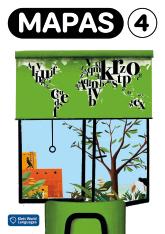
Communicate effectively in more than one language in order to function in a variety of situations and for multiple purposes
Interpersonal Communication: Learners interact and negotiate meaning in spoken, signed, or written conversations to share information, reactions, feelings, and opinions.
CAPÍTULO 1: p. 4 (act. 1, 2, 3, Foro de discusión), p. 5 (act. 6), p. 6 (act. 15, 17, 18, 19, Foro de discusión), p. 8 (act. 22, 23, 24), p. 10 (act. 26, 29, 30, 31, 32), p. 12 (act. 34, 35, 36, 37), p. 13 (act. 41, 42, 43, 44), p. 14 (act. 45, 47, 48, 49, 50), p. 15 (act. 52, 54, 55), p. 16 (act. 56), p. 17 (act. 58, 60, 61, 62, 64), p. 18 (act. 65, 67, 68), p. 19 (act. 69, 70, 71, 73, 74), p. 21 (act. 77, 78, 79, 80, 81, 82), p. 22 (act. 83), p. 23 (act. 86), p. 24 (act. 87), p. 25 (act. 90, 91), p. 26 (act. 92, 93), p. 27 (act. 94, 95, 96), p. 28 (Proyectos: En grupo)
CAPÍTULO 2: p. 44 (act. 2, 3), p. 45 (act. 6, 7, Foro de discusión), p. 46 (act. 11, 12, 13, 14, 15, Foro de discusión), p. 48 (act. 19, 20, 21, 25), p. 50 (act. 27, 28, 29), p. 51 (act. 30, 31, 32, 33, 34), p. 52 (act. 35, 36, 37, 38), p. 53 (act. 39, 40, 41, 42, 43), p. 54 (act. 46, 47, 48), p. 55 (act. 49, 50, 51, 52, 53, 54, 55), p. 56 (act. 56), p. 57 (act. 57, 58), p. 59 (act. 61, 63), p. 61 (act. 66), p. 62 (Proyectos: En grupo), p. 63 (act. c)
CAPÍTULO 3: p. 74 (act. 1,5, 6, Foro de discusión), p. 75 (act. 7, 8, 10, 11, 12), p. 76 (act. 20, 21, 22, 23), p. 78 (act. 24, 27, 28, 29, 31, Foro de discusión), p. 80 (act. 33, 34, 35, 37, 38), p. 81 (act. 39, 41, 42, 44, 45), p. 83 (act. 48, 49, 50, 54, 55), p. 84 (act. 56, 57, 58, 59, 60, 61, 62, 64, 65, 66), p. 85 (act. 67, 68, 69, 70, 71), p. 86 (act. 72, 73), p. 87 (act. 75, 76, 77, 78), p. 88 (act. 79), p. 89 (act. 81), p. 90 (act. 83), p. 91 (act. 84, 85, 86), p. 92 (Proyectos: En grupo)
CAPÍTULO 4: p. 104 (act. 3, 6, 7), p. 105 (act. 9), p. 106 (act. 14, 15, Foro de discusión), p. 108 (act. 16, 21, 22, 23, 24, 25, 26), p. 110 (act. 27), p. 111 (act. 28, 29, 30, 31, 32), p. 112 (act. 34, 35, 36, 37), p. 113 (act. 38, 39, 40), p. 115 (act. 42, 43, 44, 45, 46, 47), p. 116 (act. 51, 52), p. 117 (act. 53, 54), p. 118 (act. 57, 58, 59), p. 119 (act. 60, 61, 62, 63, 64, 65), p. 121 (act. 68, 69, 70, 71), p. 123 (act. 75, 76), p. 124 (act. 77, 78), p. 125 (act. 80, 82, 83, 84), p. 126 (Proyectos: En grupo)
CAPÍTULO 5: p. 138 (act. 2, 3, 4), p. 139 (act. 6), p. 140 (act. 11, 12, Foro de discusión), p. 142 (act. 16, 17, Foro de discusión), p. 144 (act. 20, 21, 22, 23, 24, 25, Foro de discusión), p. 146 (act. 26, 27, 28, 29), p. 147 (act. 30, 31, 32, 34, 35, 36), p. 148 (act. 38, 39), p. 149 (act. 40, 41, 42, 43, 44, 45, 46, 47, 48), p. 150 (act. 50, 51, 52, 53), p. 151 (act. 54, 55), p. 152 (act. 57, 58), p. 153 (act. 60), p. 154 (act. 62), p. 155 (act. 65, 67, 68), p. 157 (act. 72, 73, 74), p. 158 (Proyectos: En grupo)
CAPÍTULO 6: p. 172 (act. 4, 5, 6, Foro de discusión), p. 173 (act. 8), p. 174 (act. 16, 17, Foro de discusión), p. 176 (act. 18, 19, 21, 22, 23, 24), p. 179 (act. 26, 27, 28, 29, 30, 31), p. 180 (act. 32), p. 181 (act. 33, 34, 35, 36, 37), p. 182 (act. 39, 40, 41, 42), p. 183 (act. 43, 44, 45, 46, 47, 48), p. 184 (act. 49, 50, 51), p. 185 (act. 52, 53), p. 186 (act. 54, 55), p. 187 (act. 56, 57), p. 188 (act. 58), p. 189 (act. 59, 60, 61, 62), p. 190 (Proyectos: En grupo)
Interpretive Communication: Learners understand, interpret, and analyze what is heard, read, or viewed on a variety of topics.
CAPÍTULO 1: p. 4 (act. 2, 3), p. 5 (act. 4, 5), p. 6 (act. 7, 8, 9, 10, 11, 12, 13, 14, 16, 17), p. 8 (act. 20, 21, 23, 24, 25), p. 10 (act. 27, 28, 30, 32), p. 12 (act. 33, 34), p. 13 (act. 39, 40, 42), p. 14 (act. 46), p. 15 (act. 51, 53), p. 16 (act. 57), p. 17 (act. 59, 60), p. 18 (act. 65, 66), p. 19 (act. 69, 72), p. 20 (act. 75, 76), p. 22 (act. 84), p. 23 (act. 85), p. 24 (act. 88), p. 25 (act. 89), p. 27 (act. 94), p. 29 (act. b, c)
CAPÍTULO 2: p. 44 (act. 1), p. 45 (act. 4, 5), p. 46 (act. 8, 9, 10, 12, 13), p. 48 (act. 16, 17, 18, 21, 23, 24, 25), p. 50 (act. 26, 29), p. 51 (act. 30, 33), p. 52 (act 35, 37), p. 53 (act. 39, 41), p. 54 (act. 44, 45, 48), p. 55 (act. 49, 50, 51, 53), p. 56 (act. 56), p. 57 (act. 57, 58), p. 58 (act. 59), p. 59 (act. 60, 61, 62, 63), p. 60 (act. 64), p. 61 (act. 65, 66, 67)
CAPÍTULO 3: p. 74 (act. 2, 3), p. 75 (act. 9), p. 76 (act. 13, 14, 15, 16, 17, 18, 19, 21), p. 78 (act. 25, 26, 30), p. 80 (act. 32, 36), p. 81 (act. 39, 40, 43), p. 82 (act. 46, 47), p. 84 (act. 63), p. 85 (act. 67, 68, 70), p. 86 (act. 74), p. 87 (act. 76), p. 89 (act. 80), p. 91 (act. 84, 85), p. 92 (act. c), p. 93 (act. c, d)
CAPÍTULO 4: p. 104 (act. 1, 2, 4, 5), p. 105 (act. 8, 9), p. 106 (act. 10, 11, 12, 13), p. 108 (act. 17, 18, 19, 20, 23), p. 110 (act. 27), p. 112 (act. 33), p. 113 (act. 38), p. 114 (act. 41), p. 116 (act. 48, 49, 50, 52), p. 117 (act. 53, 54), p. 118 (act. 55, 56), p. 119 (act. 60, 61, 63, 64), p. 120 (act. 66, 67), p. 121 (act. 69, 70, 71), p. 122 (act. 72), p. 123 (act. 73, 74), p. 125 (act. 79, 81, 83)
CAPÍTULO 5: p. 138 (act. 1, 3), p. 139 (act. 5, 7), p. 140 (act. 8, 9, 10, 13), p. 142 (act. 14, 15), p. 144 (act. 18, 19), p. 147 (act. 33), p. 148 (act. 37), p. 149 (act. 44, 45), p. 150 (act. 49), p. 151 (act. 54, 55, 56), p. 152 (act. 58), p. 153 (act. 59), p. 155 (act. 63, 64, 65, 66), p. 156 (act. 69), p. 157 (act. 70, 71)
CAPÍTULO 6: p. 172 (act. 1, 3), p. 173 (act. 7), p. 174 (act. 10, 11, 12, 13, 14, 15, 17), p. 176 (act. 20), p. 180 (act. 32), p. 182 (act. 38), p. 183 (act. 43, 44, 45, 47, 48), p. 184 (act. 51), p. 185 (act. 52), p. 186 (act. 54), p. 187 (act. 56), p. 188 (act. 58), p. 189 (act. 59)
Presentational Communication: Learners present information, concepts, and ideas to inform, explain, persuade, and narrate on a variety of topics using appropriate media and adapting to various audiences of listeners, readers, or viewers.
CAPÍTULO 1: p. 6 (act. 18), p. 13 (act. 38), p. 17 (act. 63), p. 18 (act. 67), p. 21 (act. 79), p. 25 (act. 91), p. 26 (act. 93), p. 27 (act. 97), p. 28 (Proyectos: En grupo), p. 29 (Proyectos: Individual)
CAPÍTULO 2: p. 48 (act. 20), p. 55 (act. 55), p. 62 (Proyectos: En grupo), p. 63 (Proyectos: Individual)
CAPÍTULO 3: p. 78 (act. 25), p. 87 (act. 77), p. 89 (act. 82), p. 91 (act. 86), p. 92 (Proyectos: En grupo), p. 93 (Proyectos: Individual)
CAPÍTULO 4: p. 115 (act. 46), p. 118 (act. 58), p. 126 (Proyectos: En grupo), p. 127 (Proyectos: Individual)
CAPÍTULO 5: p. 139 (act. 7), p. 155 (act. 63), p. 158 (Proyectos: En grupo), p. 159 (Proyectos: Individual)
CAPÍTULO 6: p. 172 (act. 2), p. 173 (act. 9), p. 174 (act. 17), p. 176 (act. 23), p. 178 (act. 25), p. 181 (act. 37), p. 189 (act. 61), p. 190 (Proyectos: En grupo), p. 191 (Proyectos: Individual)
Interact with cultural competence and understanding
Relating Cultural Practices to Perspectives: Learners use the language to investigate, explain, and reflect on the relationship between the practices and perspectives of the cultures studied.
CAPÍTULO 1: p. 24 (act. 88)
CAPÍTULO 2: p. 45 (act. 7), p. 58 (act. 59), p. 59 (act. 60, 61, 63)
CAPÍTULO 3: p. 87 (act. 76)
CAPÍTULO 4: p. 105 (act. 8, 9), p. 108 (act. 16, 18, 19, 26), p. 110 (act. 27), p. 111 (act. 32), p. 112 (act. 33, 36), p. 113 (act. 40), p. 114 (act. 41, 46), p. 116 (act. 50, 52), p. 118 (act. 55, 56, 58), p. 120 (act. 67), p. 121 (act. 69), p. 123 (act. 73), p. 126 (Proyectos: En grupo), p. 127 (Proyectos: Individual)
CAPÍTULO 5: p. 144 (act. 19)
Relating Cultural Products to Perspectives: Learners use the language to investigate, explain, and reflect on the relationship between the products and perspectives of the cultures studied.
CAPÍTULO 1: p. 4 (act. 2), p. 24 (act. 88), p. 26 (act. 93), p. 27 (act. 94)
CAPÍTULO 2: p. 44 (act. 1), p. 46 (act. 14), p. 52 (act. 36), p. 54 (act. 45), p. 59 (act. 60, 61, 63), p. 61 (act. 65)
CAPÍTULO 3: p. 74 (act. 3), p. 89 (act. 80, 82), p. 91 (act. 84), p. 92 (Proyectos: En grupo)
CAPÍTULO 4: p. 104 (act. 4, 5), p. 112 (act. 33, 36), p. 115 (act. 46), p. 116 (act. 50, 52), p. 117 (act. 53, 54), p. 124 (act. 77), p. 125 (act. 79, 83)
CAPÍTULO 5: p. 140 (act. 8, 11), p. 144 (act. 18, 19), p. 154 (act. 61, 62), p. 155 (act. 63, 64), p. 157 (act. 70, 71), p. 158 (Proyectos: En grupo)
CAPÍTULO 6: p. 173 (act. 7)
Connect with other disciplines and acquire information and diverse perspectives in order to use the language to function in academic and career related situations
Making Connections: Learners build, reinforce, and expand their knowledge of other disciplines while using the language to develop critical thinking and to solve problems creatively.
CAPÍTULO 1: p. 16 (act. 57), p. 18 (act. 66), p. 19 (act. 74), p. 20 (act. 75, 76), p. 24 (act. 88), p. 29 (Proyectos: Individual)
CAPÍTULO 2: p. 48 (act. 16, 17, 18, 19, 20, 21, 22, 23, 24, 25), p. 57 (act. 57), p. 60 (act. 64), p. 61 (act. 65)
CAPÍTULO 3: p. 86 (act. 74), p. 88 (act. 79), p. 91 (act. 84), p. 93 (Proyectos: Individual)
CAPÍTULO 4: p. 118 (act. 55), p. 121 (act. 70)
CAPÍTULO 5: p. 144 (act. 18, 19), p. 152 (act. 58), p. 153 (act. 59), p. 158 (Proyectos: En grupo), p. 159 (Proyectos: Individual)
CAPÍTULO 6: p. 180 (act. 32), p. 184 (act. 51), p. 185 (act. 52), p. 187 (act. 56, 57)
Acquiring Information and Diverse Perspectives: Learners access and evaluate information and diverse perspectives that are available through the language and its cultures.
CAPÍTULO 1: p. 4 (act. 1), p. 5 (act. 5), p. 6 (act. 7), p. 8 (act. 20, 21), p. 10 (act. 27), p. 13 (act. 38, 39), p. 16 (act. 57), p. 18 (act. 65), p. 20 (act. 76), p. 21 (act. 79), p. 22 (act. 84), p. 23 (act. 85), p. 24 (act. 88), p. 25 (act. 91), p. 26 (act. 93), p. 27 (act. 94, 96), p. 29 (act. a, b)
CAPÍTULO 1: p. 46 (act. 14), p. 48 (act. 16, 18), p. 51 (act. 30), p. 52 (act. 36), p. 57 (act. 57), p. 58 (act. 59), p. 59 (act. 60, 61, 63), p. 61 (act. 65, 67)
CAPÍTULO 3: p. 74 (act. 2), p. 76 (act. 23), p. 78 (act. 25), p. 82 (act. 47), p. 83 (act. 51, 52, 53), p. 84 (act. 63), p. 86 (act. 74), p. 87 (act. 76), p. 89 (act. 80, 82), p. 91 (act. 84), p. 92 (act. a, c)
CAPÍTULO 4: p. 104 (act. 4, 5), p. 105 (act. 8, 9), p. 108 (act. 18, 19), p. 110 (act. 27), p. 112 (act. 33, 36), p. 113 (act. 40), p. 114 (act. 41), p. 115 (act. 46), p. 116 (act. 50, 52), p. 117 (act. 53, 54), p. 118 (act. 55, 56, 58), p. 120 (act. 66, 67), p. 121 (act. 70), p. 123 (act. 73), p. 124 (act. 77), p. 125 (act. 79, 83), p. 126 (act. a), p. 127 (act. a), p. 138 (act. 1)
CAPÍTULO 5: p. 139 (act. 7), p. 140 (act. 8, 11), p. 142 (act. 14, 17), p. 144 (act. 18, 19), p. 152 (act. 58), p. 153 (act. 59), p. 154 (act. 61, 62), p. 155 (act. 63, 68), p. 157 (act. 70, 71, 74), p. 158 (act. a), p. 159 (act. b)
CAPÍTULO 6: p. 172 (act. 2, 5), p. 174 (act. 10), p. 176 (act. 20, 22), p. 180 (act. 32), p. 181 (act. 37), p. 184 (act. 51), p. 185 (act. 52), p. 187 (act. 56, 57), p. 189 (act. 59, 61)
Develop insight into the nature of language and culture in order to interact with cultural competence
Language Comparisons: Learners use the language to investigate, explain, and reflect on the nature of language through comparisons of the language studied and their own.
CAPÍTULO 1: p. 19 (act. 69, 74)
CAPÍTULO 2: p. 54 (act. 47)
CAPÍTULO 3: p. 74 (act. 6), p. 81 (act. 41), p. 83 (act. 48)
CAPÍTULO 4: p. 119 (act. 62)
CAPÍTULO 5: p. 144 (act. 21)
Cultural Comparisons: Learners use the language to investigate, explain, and reflect on the concept of culture through comparisons of the cultures studied and their own.
CAPÍTULO 2: p. 45 (act. 7)
CAPÍTULO 3: p. 80 (act. 32)
CAPÍTULO 4: p. 108 (act. 16), p. 111 (act. 32), p. 121 (act. 69)
CAPÍTULO 5: p. 140 (act. 12)
Communicate and interact with cultural competence in order to participate in multilingual communities at home and around the world
School and Global Communities: Learners use the language both within and beyond the classroom to interact and collaborate in their community and the globalized world.
CAPÍTULO 1: p. 13 (act. 44), p. 14 (act. 50), p. 27 (act. 97), p. 28 (Proyectos: En grupo), p. 29 (Proyectos: Individual)
CAPÍTULO 2: p. 62 (Proyectos: En grupo), p. 63 (Proyectos: Individual)
CAPÍTULO 3: p. 76 (act. 23), p. 92 (Proyectos: En grupo), p. 93 (Proyectos: Individual)
CAPÍTULO 3: p. 113 (act. 40), p. 126 (Proyectos: En grupo), p. 127 (Proyectos: Individual)
CAPÍTULO 5: p. 140 (foro de discusión), p. 142 (foro de discusión), p. 150 (act. 49), p. 158 (Proyectos: En grupo), p. 159 (Proyectos: Individual)
CAPÍTULO 6: p. 187 (act. 57), p. 189 (act. 61)
Lifelong Learning: Learners set goals and reflect on their progress in using languages for enjoyment, enrichment, and advancement.
CAPÍTULO 3: p. 86 (act. 72), p. 92 (proyectos en grupo)
CAPÍTULO 6: p. 178 (act. 25), p. 184 (act. 49), p. 190 (Proyectos: En grupo), p. 191 (Proyectos: Individual)

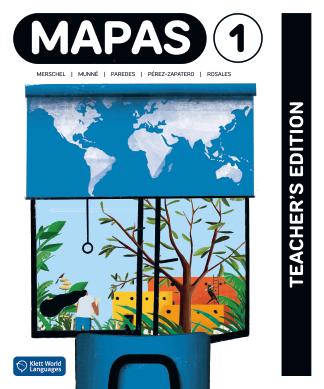
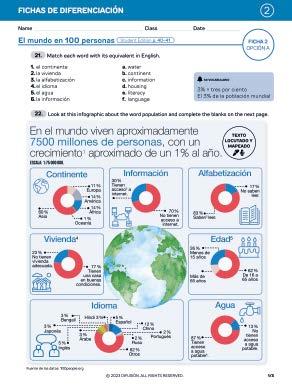




AP and IB correlations
50-minute and 90-minute lesson plans
Pacing guide
Implementation guide
Grammar and pronunciation tutorials
Additional projects
Cultural comparisons worksheets
